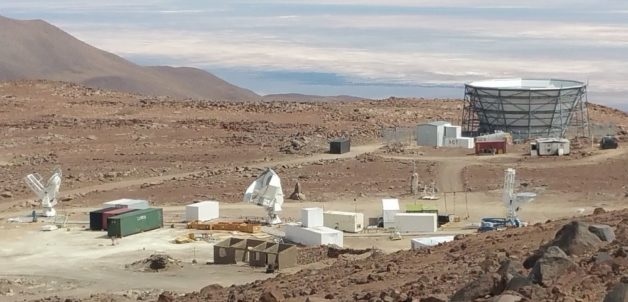
Chris Chang and UC Berkeley graduate student Sumin Lee carry out experiments to find proteins that bind to copper and potentially influence the storage and burning of fat. (Credit: Peg Skorpinski/UC Berkeley)
Long prized as a malleable, conductive metal used in cookware, electronics, jewelry and plumbing, copper has been gaining increasing attention over the past decade for its role in certain biological functions. It has been known that copper is needed to form red blood cells, absorb iron, develop connective tissue and support the immune system.
The new findings, to appear in the July print issue of Nature Chemical Biology but published online today, establishes for the first time copper’s role in fat metabolism.
The team of researchers was led by Chris Chang, a faculty scientist at Berkeley Lab’s Chemical Sciences Division, a UC Berkeley professor of chemistry and a Howard Hughes Medical Institute investigator. Co-lead authors of the study are Lakshmi Krishnamoorthy and Joseph Cotruvo Jr, both UC Berkeley postdoctoral researchers in chemistry with affiliations at Berkeley Lab.
“We find that copper is essential for breaking down fat cells so that they can be used for energy,” said Chang. “It acts as a regulator. The more copper there is, the more the fat is broken down. We think it would be worthwhile to study whether a deficiency in this nutrient could be linked to obesity and obesity-related diseases.”
Dietary copper
Chang said that copper could potentially play a role in restoring a natural way to burn fat. The nutrient is plentiful in foods such as oysters and other shellfish, leafy greens, mushrooms, seeds, nuts and beans.
According to the Food and Nutrition Board of the Institute of Medicine, an adult’s estimated average dietary requirement for copper is about 700 micrograms per day. The Food and Nutrition Board also found that only 25 percent of the U.S. population gets enough copper daily.
“Copper is not something the body can make, so we need to get it through our diet,” said Chang. “The typical American diet, however, doesn’t include many green leafy vegetables. Asian diets, for example, have more foods rich in copper.”
But Chang cautions against ingesting copper supplements as a result of these study results. Too much copper can lead to imbalances with other essential minerals, including zinc.
Copper as a ‘brake on a brake’
The researchers made the copper-fat link using mice with a genetic mutation that causes the accumulation of copper in the liver. Notably, these mice have larger than average deposits of fat compared with normal mice.

A fluorescent probe creates a heat map of copper in white fat cells. Higher levels of copper are shown in yellow and red. The left panel shows normal levels of copper from fat cells of control mice, and the right panel shows cells deficient in copper. (Credit: Lakshmi Krishnamoorthy and Joseph Cotruvo Jr./UC Berkeley)
The inherited condition, known as Wilson’s disease, also occurs in humans and is potentially fatal if left untreated.
Analysis of the mice with Wilson’s disease revealed that the abnormal buildup of copper was accompanied by lower than normal lipid levels in the liver compared with control groups of mice. The researchers also found that the white adipose tissue, or white fat, of the mice with Wilson’s disease had lower levels of copper compared with the control mice and correspondingly higher levels of fat deposits.
They then treated the Wilson’s disease mice with isoproterenol, a beta agonist known to induce lipolysis, the breakdown of fat into fatty acids, through the cyclic adenosine monophosphate (cAMP) signaling pathway. They noted that the mice with Wilson’s disease exhibited less fat-breakdown activity compared with control mice.
The results prompted the researchers to conduct cell culture analyses to clarify the mechanism by which copper influences lipolysis. The researchers used inductively coupled plasma mass spectroscopy (ICP-MS) equipment at Berkeley Lab to measure levels of copper in fat tissue.
They found that copper binds to phosphodiesterase 3, or PDE3, an enzyme that binds to cAMP, halting cAMP’s ability to facilitate the breakdown of fat.
“When copper binds phosphodiesterase, it’s like a brake on a brake,” said Chang. “That’s why copper has a positive correlation with lipolysis.”
Hints from cows and copper
The connection between copper and fat metabolism is not altogether surprising. The researchers actually found hints of the link in the field of animal husbandry.
“It had been noted in cattle that levels of copper in the feed would affect how fatty the meat was,” said Chang. “This effect on fat deposits in animals was in the agricultural literature, but it hadn’t been clear what the biochemical mechanisms were linking copper and fat.”
The new work builds upon prior research from Chang’s lab on the roles of copper and other metals in neuroscience. In support of President Barack Obama’s BRAIN Initiative, Berkeley Lab provided Chang seed funding in 2013 through the Laboratory Directed Research and Development program. Chang’s work continued through the BRAIN Tri-Institutional Partnership, an alliance with Berkeley Lab, UC Berkeley and UC San Francisco.
Of the copper in human bodies, there are particularly high concentrations found in the brain. Recent studies, including those led by Chang, have found that copper helps brain cells communicate with each other by acting as a brake when it is time for neural signals to stop.
While Chang’s initial focus was on the role of copper in neural communications, he branched out to investigations of metals in fat metabolism and other biological pathways. This latest work was primarily funded by the National Institutes of Health.
Previous stories on Chris Chang’s research on copper include:
Copper on the Brain at Rest
Of Metal Heads and Imaging
A profile of Chris Chang is online through the UC Berkeley Office of the Vice Chancellor for Research.
See the full article here .
Please help promote STEM in your local schools.
A U.S. Department of Energy National Laboratory Operated by the University of California













































